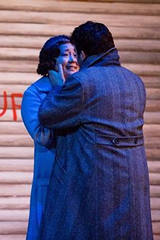| Opera Reviews | 27 April 2024 |
Love, laughter and death at the heart of Scottish Opera's new Bohèmeby Catriona Graham |
|
| Puccini: La bohème Scottish Opera May 2017 |
|
|
The performance starts, unconventionally, in the tourist-trap flea-market, all Art Deco junk. An elegant woman sings to an accordion accompaniment while tourists haggle and a small boy head-bangs to his smart-phone. A man plays a scratchy recording of the overture and the orchestra fades in; the junk becomes the furniture of the Bohemians’ flat. Luis Gomes is a young Rodolpho, larking about with flatmates Marcello (David Stout), Schaunard (Božidar Smiljanić) and Colline (Damien Pass), but still with a sense of duty; while the others go out on the town, he has writing to finish, and so he meets Mimi. Could this be his first serious love? It certainly seems that way. She is as keen as him, and they go out to meet the others. The town is heaving – merry-go-rounds, bands, a man on stilts, Parpignol the toy-seller on a sort of hobby-horse, parents with squabbling children. And the friends get a table, next to Marcello’s girlfriend, Musetta, who has been taking her gentleman friend shopping; Jeanine De Bique is elegant in brilliant white with a pet leopard, à la Josephine Baker, and has a voice and style that explains Marcello’s besottedness. The colour and verve of André Barbe’s designs, Guy Simard’s lighting and Renaud Doucet’s direction fill the stage with action but never overwhelm the dramas taking place amongst the principal characters – while Musetta is the centre of everyone’s attention, Mimi and Rodolpho are quietly getting on. Act 3 starts back in present time, as the street-cleaners come in, wearing hi-viz jackets and collecting black plastic bin-bags, but Mimi's arrival returns us to the jazz-age. Her conversation with Marcello is so naturalistic – Stout’s voice is a good foil for hers. In turn, when Rodolpho sings of his fears for Mimi, we understand Marcello’s compassion. Djordje Gajic plays the accordion to cover the scene-change for Act 4, which starts behind a gauze, as Marcello and Rodolpho compare news of their (ex)-girlfriends. The others arrive and there is more larking till Musetta arrives with a dying Mimi. So well have they created their characters, the patent grief of the friends is entirely natural. Colline’s ode to his old coat is no philosophical affectation, but a genuine act of kindness. Mimi’s death-bed – the sofa - can be mawkish; here it is dignified, with the friends mixing tact and compassion with a desperation to do what they can to preserve her life. And here the orchestra, conducted by Stuart Stratford, excels itself, holding its nerve for the silences. Elsewhere, however, it can overwhelm the singing, particularly Gomes. As she dies, the friends gather round the sofa, to pay respects. When they leave, the sofa is empty. It is a fitting symbol of the place she has had in their lives.
|
|
| Text ©
Catriona Graham Photo © Sally Jubb |

 From the moment that Hye-Youn-Lee sings Sì, mi chiamano Mimì, we are charmed, in Scottish Opera’s new production of La bohème. She plays the part delightfully, sweet, not saccharine, her voice slipping through the notes with ease, creating a genuine conversation with her new boyfriend.
From the moment that Hye-Youn-Lee sings Sì, mi chiamano Mimì, we are charmed, in Scottish Opera’s new production of La bohème. She plays the part delightfully, sweet, not saccharine, her voice slipping through the notes with ease, creating a genuine conversation with her new boyfriend.






